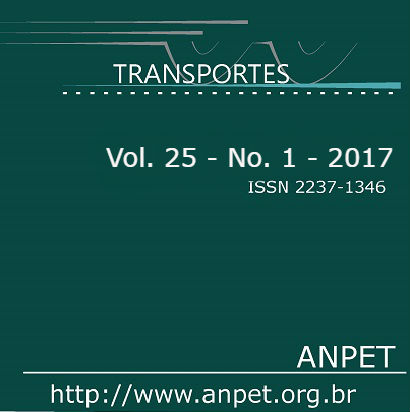Aplicação de um algoritmo genético ao problema de rodízio de tripulações do sistema de transporte público urbano
DOI:
https://doi.org/10.14295/transportes.v25i1.1074Keywords:
Crew rostering problem, Crew scheduling, Genetic algorithms.Abstract
This paper addresses the resolution of the Crew Rostering Problem (CRP). The problem consists of assigning duties to the crew members of a company over a given planning horizon, in order to minimize its total costs. The number of crews required to perform all journeys is considered as the fixed costs, while the accumulated overtime hours and idle hours for each crew are the variables costs. In the resolution of this problem, it must be considered the labor laws and the operational constraints of each company. In this paper, we solved the CRP in two stages. In the first of them, we defined the rest period, minimizing the total number of crews. In the second stage, we allocated the duties to be performed by crews, minimizing idle and overtime hours. Both stages were solved using a Genetic Algorithm, a novel CRP approach to Brazilian cases. The algorithm was designed to solve a real case from a company and its results were compared with the exact solutions obtained by an Integer Programming Model, indicating to be competitive.Downloads
References
Ahuja, R. K., Magnanti, T. L. e Orlin, J. B. (1993) Network Flows: Theory, Algorithms, and Applications. Prentice Hall, New Jersey.
Bianco, L., BieIli, M., Mingozzi, A., Ricciardelli, S. e Spadoni, M. (1992) A heuristic procedure for the crew rostering problem, European Journal of Operations Research, 58(2), p. 272–283.
DOI:10.1016/0377-2217(92)90213-S
Boas, M. G. V. e Silva, G. P. (2014) Modelos de Programação Inteira para o Problema de Rodízio de Tripulações de Ônibus Urbano. Anais do XLVI Simpósio Brasileiro de Pesquisa Operacional, p. 1-12.
Caprara, A., Monaci, M. e Toth, P. (2003) Models and algorithms for a staff scheduling problem, Mathematical Programming, 98(1–3), p. 445–476.
DOI:10.1007/s10107-003-0413-7
Carraresi, P. e Gallo, G. (1984) A multi-level bottleneck assignment approach to the bus drivers rostering problem, European Journal of Operational Research, 16(2), p. 163–173.
DOI:10.1016/0377-2217(84)90071-7
Ernst, A. T.; Jiang, H.; Krishnamoorthy, M. e Sier, D. (2004) Staff scheduling and rostering: A review of applications, methods and models, European Journal of Operational Research, 153, p. 3–27.
DOI:10.1016/S0377-2217(03)00095-X
Goldberg, D. E. (1989) Genetic Algorithms in Search, Optimization and Machine Learning. Addison-Wesley, Berkeley.
Holland, J. H. (1975) Adaptation in Natural and Artificial Systems. University of Michigan Press.
Kruskal, W. H.. e Wallis, W. A. (1952) Use of ranks in the one criterium variance analysis, Journal of American Statistical Association, 47(260), p. 583-621.
DOI:10.1080/01621459.1952.10483441
Leite, P. V. S. (2012) Resolução do Problema de Rodízio de Tripulações Usando um Modelo de Fluxo em Redes. Trabalho de Conclusão de Curso, Departamento de Engenharia de Controle e Automação, Universidade Federal de Ouro Preto.
Mayrink, V. T. M. e Silva, G. P. (2013) Otimização do rodízio de tripulações do sistema de transporte público, Journal of Transport Literature, 7(3), p. 192–213.
DOI:10.1590/S2238-10312013000300009
Silva, G. P. e Prates, R. F. C. (2014) Otimização da Escala Mensal de Motoristas de Ônibus Urbano Utilizando a Metaheurística Variable Neighborhood Search, TRANSPORTES, 22(1), p. 31–43.
DOI:10.14295/transportes.v22i1.698
Talbi, E. G. (2009) Metaheuristics: from design to implementation. John Wiley & Sons.
Toffolo, T. A., Souza, M. J. F. e Silva, G. P. (2005) Resolução do Problema de Rodízio de Tripulações de Ônibus Urbano via Simulated Annealing e Iterated Local Search, Anais do XIX Congresso de pesquisa e Ensino em Transportes, ANPET, 2, p. 657–668.
Whitley, D. (1994) A Genetic Algorithm Tutorial, Computer Science Department, Colorado State University, Fort Collins, CO 80523.
DOI:10.1007/BF00175354
Downloads
Published
How to Cite
Issue
Section
License
Authors who submit papers for publication by TRANSPORTES agree to the following terms:
- The authors retain the copyright and grant Transportes the right of first publication of the manuscript, without any financial charge, and waive any other remuneration for its publication by ANPET.
- Upon publication by Transportes, the manuscript is automatically licensed under the Creative Commons License CC BY 4.0 license. This license permits the work to be shared with proper attribution to the authors and its original publication in this journal.
- Authors are authorized to enter into additional separate contracts for the non-exclusive distribution of the version of the manuscript published in this journal (e.g., publishing in an institutional repository or as a book chapter), with recognition of the initial publication in this journal, provided that such a contract does not imply an endorsement of the content of the manuscript or the new medium by ANPET.
- Authors are permitted and encouraged to publish and distribute their work online (e.g., in institutional repositories or on their personal websites) after the editorial process is complete. As Transportes provides open access to all published issues, authors are encouraged to use links to the DOI of their article in these cases.
- Authors guarantee that they have obtained the necessary authorization from their employers for the transfer of rights under this agreement, if these employers hold any copyright over the manuscript. Additionally, authors assume all responsibility for any copyright infringements by these employers, releasing ANPET and Transportes from any responsibility in this regard.
- Authors assume full responsibility for the content of the manuscript, including the necessary and appropriate authorizations for the disclosure of collected data and obtained results, releasing ANPET and Transportes from any responsibility in this regard.










